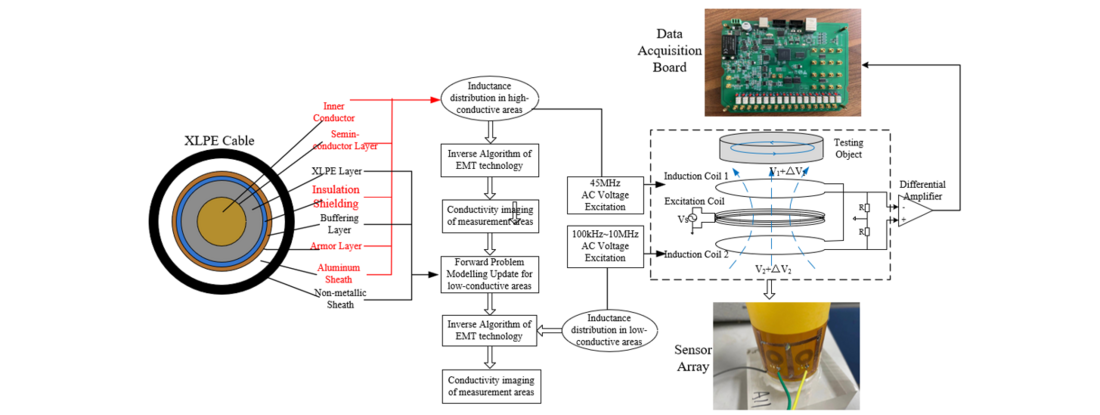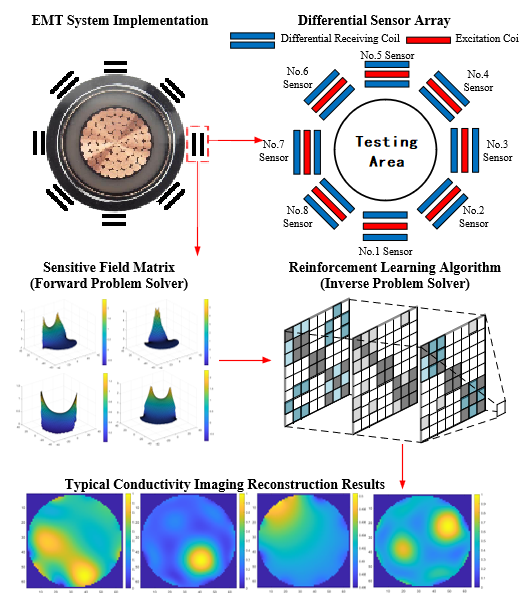Visualized Reconstruction of Treeing Defects in Power Cable Based on Electromagnetic Tomography
Defects in High Voltage XLPE shielded power cable are normally hard to observed due to its unique structure. Electrical tomography (EMT) technology might be a solution to visualize the defects inside the power cable and to prevent unplanned power outage.
by Yingqiang Shang
Background
XLPE cables are prone to insulation aging faults such as water trees and electrical trees during long-term operation. Once treeing defects occur, they could lead to discharge or breakdown in XLPE cable, seriously threaten the security and reliability of the power transmission network [1]. Non-destructive testing methods can achieve online monitoring of cable internal faults to a certain extent, however, existing cable non-destructive testing methods such as X-ray, ultrasonic-imaging and Terahertz-tomography have different disadvantages, including radiation risks, relying on couplant and difficulties in penetrating metallic materials [2]. Electrical tomography (EMT) is an imaging technique based on the principle of electromagnetic induction which was first developed in the 80s of the 20th century. EMT technology is known for its unique advantages of non-invasive, non-contact, and permeable through metal media [3]. It is particularly good at visualizing 3-D reconstruction of low-conductivity objects, which is promising in non-destructive testing of electrical and water tree faults in XLPE cables.
Recently, Beijing electric power company in China proposes a trial project in adopting EMT tomography for non-contact detection of treeing defects in 35 kV and 110 kV XLPE cables. The working principle for the EMT system is shown in Fig. 1.

Figure 1 - Working Principle of EMT system in treeing fault detection
The hardware of the EMIT system includes 8-way sensor array, coil excitation and signal measurement circuit, data acquisition card, DC power supply and FPGA board, and the software is embedded in LabVIEW program. EMT adopts the working mode of coil excitation and receiving measurement, and the measured target, i.e., XLPE cable, does not need to contact with the measurement system directly, eliminating the influence of electrode contact. In order to obtain more independent measurement values as much as possible, the system generally adopts the measurement mode of multi-excitation and multi-detection, and arranges multiple sensors around the measurement area to form an array mode. Alternating current is applied to the excitation coil to generate parallel or sector excitation magnetic field in the measurement space. The secondary magnetic field modulated by the measured object is detected through the receiving coil, and the medium distribution in the measurement space is reconstructed after data inversion.
Methodology
Typical measurement case of EMT technology is shown in Fig. 2.

Figure 2 - Typical measurement case of EMT technology
It is indicated that the application of EMT technology in treeing detection of XLPE cable has the following advantages:
1. Non-destructive testing
EMT does not damage the internal structure of the cable, therefore the introduction of impurities and other risks to damage the safe operation of cable equipment can be avoided. Whereas there is no radiation risk to personnel compared with other non-destructive testing technology. In addition, electromagnetic tomography can achieve more excellent non-destructive testing with low cost and ease of use.

2. Accurate imaging
In the trial project, the imaging reconstruction error of cable internal defects is reduced by using a self-developed algorithm of fusion deep neural network, and the response speed of defect identification and the precision reconstruction of low conductivity area are further improved. It is expected that micro discharge channels with the sizes of micrometers can be detected by EMT technology.
3. Synchronous detections of defects in insulation and metal layers
EMT technology generates an exciting magnetic field in the measurement space by applying alternating current to the excitation coil installed around the measurement object. Multiple receiving coils located in different directions are used to detect the secondary magnetic field generated by the object to be measured. After inversion calculation, the spatial medium distribution is reconstructed. By adopting coaxial differential sensor arrays, the effects of primary magnetic field can be eliminated, which makes the synchronous detections of discharge microchannels in insulation layer with low-conductivity and metal corrosion/damage with high-conductivity become possible.
Challenges
It is noteworthy that the Assessment of EMT technology by Beijing electric power company is a demonstration program, looking forward to the desire for applying EMT technology in power transmission projects with XLPE cable rated 110 kV and above, technical challenges remain in terms of system design and inverse algorithm improvement:
1. Optimization of sensor array designs
The alternating magnetic field generated by the excitation of the electromagnetic field sensor is generally divergent and has poor directivity. This results in a limited measurement distance and a nonlinear spatial sensitivity of the sensor. It is desired to design novel electromagnetic field sensors with strong directivity and focusing characteristics through theoretical analysis or simulation calculation, the spatial sensitivity performance of the electromagnetic field sensor can be improved fundamentally from the sensitivity mechanism as well.
2. Dynamic architecture of EMT system
In order to ensure the high precision and stability of the EMT measurement signal during practical operation of XLPE cables, further improvements in the measurement speed of the hardware system should be achieved. Since imaging requires high measurement accuracy, stability and accuracy are inevitably sacrificed when frame rate is increased. How to design a dynamic EMT system with high precision and high frame rate is a challenge to the design the top structure of EMT system.
3. Developing high-dimensional nonlinear imaging algorithms
At present, the research of imaging algorithms mainly focuses on the reconstruction of 2-D images, and the system model is also linearized matrix operation. However, considering the 3-D and nonlinear properties of the electromagnetic field distribution, more complex high-dimensional solutions can be further considered in the inversion calculation, and more abundant spatial distribution information can be obtained. However, the complexity of physical field calculation and the scale of system matrix would increase dramatically. How to develop a more efficient inverse problem solving framework should be considered for further implementation of EMT system.
Conclusion
EMT technology offers a high-precision non-destructive testing and reconstruction method for observing treeing defects in XLPE cables, which can locate and imaging the treeing defects in insulation layers with high accuracy. In addition, the operation of the EMT device is safer than that of X-ray detection, with other advantages including low cost, portability, non-contact, anti-electromagnetic interference. It is expected that the application of EMT technology could guarantee the security and reliability of XLPE cable powered transmission tunnels.
Acknowledgement
The author would like to express his sincere appreciate for advises from Prof. Wu Lu from Shanghai University of Electric Power. Also to 3 engineers who provide helps during the trial project, They are: Shiling Wei, Qing liu and Yang Zhao
About the author

Yingqiang Shang was born on 13th April 1990 in China. He received the PhD degree from The University of Manchester in Electrical and Electronic Engineering in 2019. Afterwards, he has been working at SGCC Beijing power cable company as a senior engineer to innovate new technology and equipment used for HV power cables.
He has joined CIGRE as a Working Group young member since 2023.
Thumbnail credit: Artur Nichiporenko on iStock
- [1] X. Chen, Y. Xu, X. Cao, S. J. Dodd and L. A. Dissado, “Effect of tree channel conductivity on electrical tree shape and breakdown in XLPE cable insulation samples,” in IEEE Transactions on Dielectrics and Electrical Insulation, vol. 18, no. 3, pp. 847-860, 2011.
- [2] Z. W. Zhang, J. Xu, R. Jia, Y. H. Wu, H. Guan, S. Y. Han, C. L. Zhang and Y. J. Zhao, “Terahertz Non-Destructive Testing and Imaging of High-Voltage Cables”, in Frontiers in Physics, vol. 10, 2022.
- [3] J. Xiang, Y. Dong, and Y. Yang, “Multi-frequency electromagnetic tomography for acute stroke detection using frequency-constrained sparse bayesian learning”. in IEEE Transactions on Medical Imaging, vol. 39, pp 4102-4112, 2020